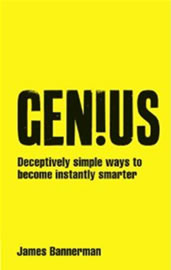Genius
Deceptively simple ways to become smarter

James Bannerman
Publications: Pearson
Reviewer : Mike Bagshaw
Any intelligent fool can make things bigger and more complex... It takes a touch of genius - and a lot of courage to move in the opposite direction.
- Albert Einstein
It is becoming increasingly obvious that innovation is one of the most important keys to business success in the knowledge-based economy. The ever-increasing rate of technological change is resulting in shorter and shorter product cycles, which drives companies toward continuous innovation. But innovation is not something that just happens on its own. It requires special expertise, work practices and methodologies that are not yet widely adopted. Generating new ideas is difficult enough, but then choosing the ideas that are most likely to succeed is also challenging.
Many organisations are not harnessing the full innovation potential of their people to maximise profitability. Exploiting new ideas can give you competitive edge in times of rapid change, complexity and volatility. However, the failure rate for innovation is high. The global innovation success average according to research conducted by Doblin Inc. is 4 %.( see www.doblin.co)
For organisations to gain competitive advantage, they need creativity – thinking up new things, and innovation – doing things differently to add value. Research and experience tells us that you get more innovation from a culture that taps into a range differing talents and expertise. This book is an indispensable aid to that process.
I first came across the author of ‘Genius,’ James Bannerman, about 10 years ago when we designed a course together called ‘Creative Collaboration’ for a finance organisation. I was struck by the fact that James was genuinely creative. Ideas flow from him like a disturbed flock of birds.
He was the first person I met in the area of creativity and innovation who could make brainstorming really work. And that’s what distinguishes this book. It is full of tools that do work. I’ve tried them with management groups, and they really do help people connect with their creativity.
A basic premise of the book is that we are all creative. We don’t need to rely on just a few geniuses with ideas. This is an idea whose time has come, because organisations need creativity at all levels. We don’t just need new innovative products and services; we need innovation across the whole chain of activities in the organisation.
The book is readable and practical. In my experience as a management trainer, delegates invariably want to take away tools that they can use immediately. This book does just that. So, for the general manager who doesn’t mind jumping in with his team to come up with ideas this is a great book.
My other role is as a university lecturer. This is not a book that takes a critical academic look at creativity. It doesn’t refer to the wider creativity and innovation debate with reference to the evidence from research, or the extensive theory literature, and there is no bibliography. Nevertheless the material is based on sound research, and it does provide a wealth of examples to reinforce the application of the tools. Some follow-up source material would have been helpful though.
The most original part of the book is the author’s acronym CANDO, which represents five tools for creativity. It echoes a list of methods called SCAMPER (Michalko 2006), but these five tools are explained much more practically, in such a way that the reader wants to use them immediately. This is a must for management trainers, and is also useful for the general reader who wants to explore different ways of dealing with day-to-day problems.
Although the author doesn’t provide the evidence for the efficacy of his methods, they give the individual the opportunity to try them out, and seek their own evidence. It truly is a book of tools, where you can say “If it works, don’t knock it.”
I suspect this book is only a start. I can envisage follow-up creativity texts for specific groups and issues. What about creative methods for dealing with difficult relationships, or for managing your career, or dealing with stress. I can also see a website being developed.
In summary, this is a practical and accessible text for all of us to enhance our dormant creativity. It is a generous book in that it is not afraid to give away the golden nuggets that James has found to work. Stephen Covey talked about abundance mentality and a scarcity mentality. A scarcity mentality feels that giving away a good idea is to lose it, while an abundance mentality feels that it gains from letting the idea loose where it can grow. James Bannerman has an abundance mentality, and that is the mentality of a true creative. The well of ideas is unlimited, and when you give ideas away, they can lead to the creation of new opportunities.
As Daniel Pink (2005)pointed out the era of "left brain" dominance, and the Information Age that it engendered, are giving way to a new world, the ‘Conceptual Age’, in which "right brain" qualities-inventiveness, empathy, meaning-predominate. This book is firmly in this new world.
Pink, Daniel H. (2005), A Whole New Mind. New York: RiverheadBooks.
Michalko, M. (2006).Thinkertoys: A Handbook of Creative-Thinking Techniques (2nd Edition) [Paperback] Ten Speed Press.


